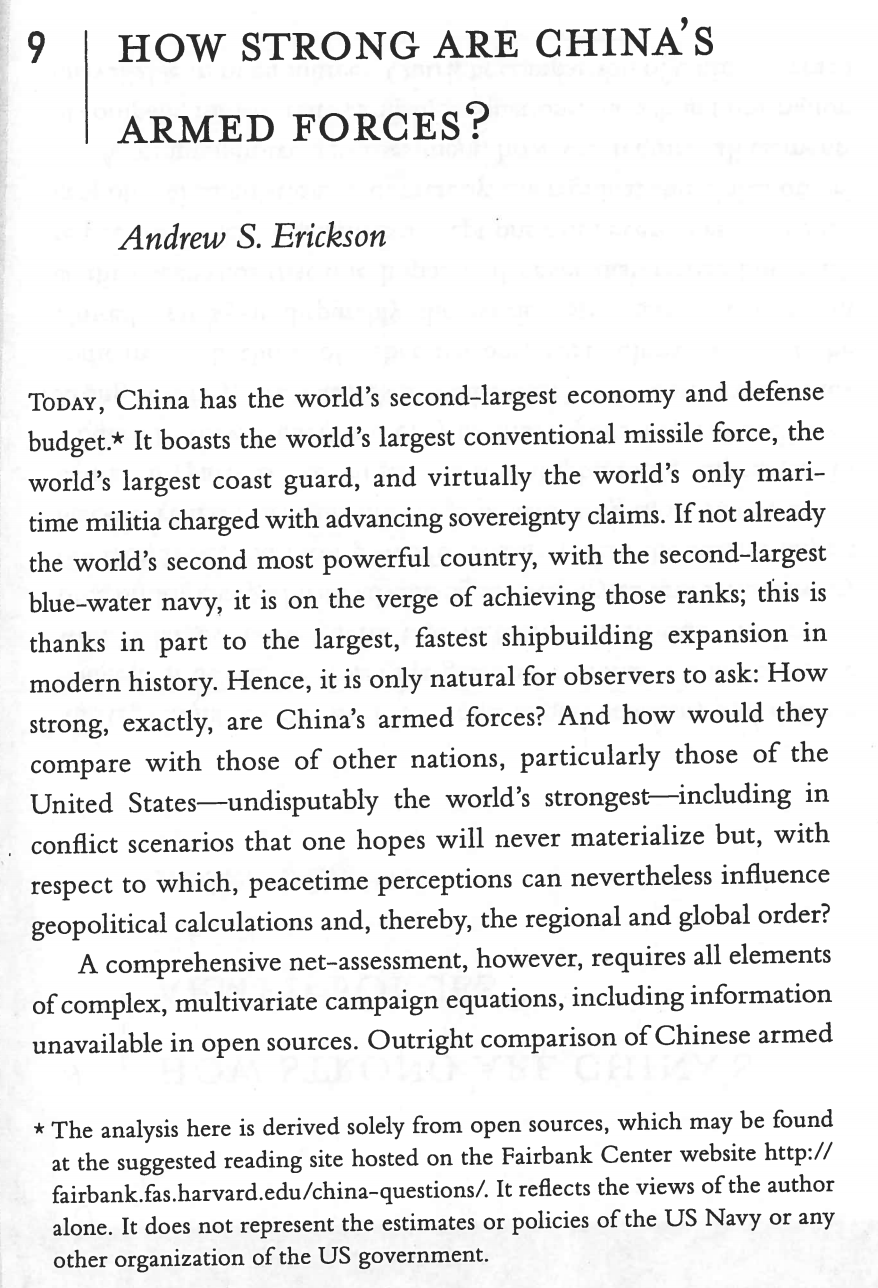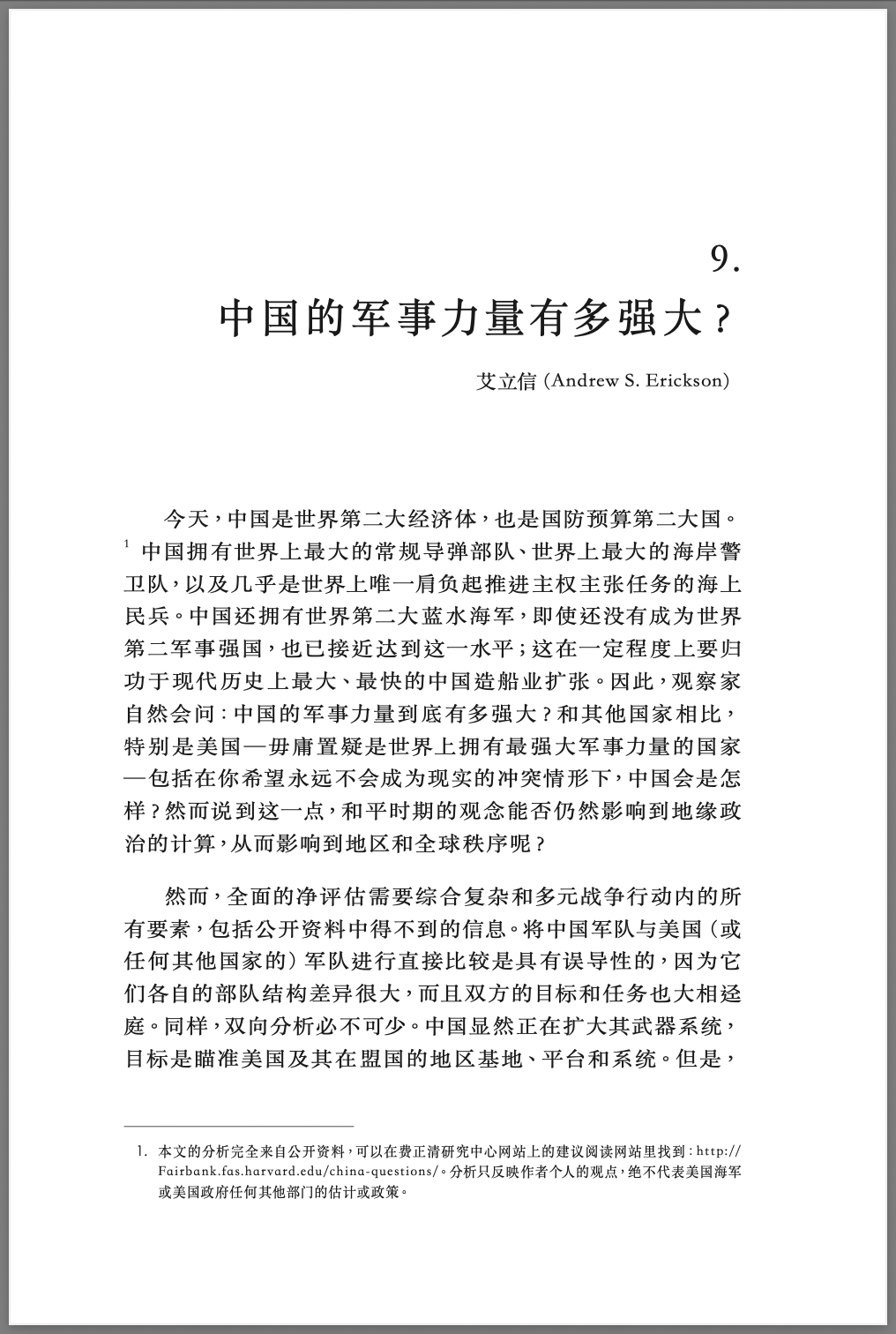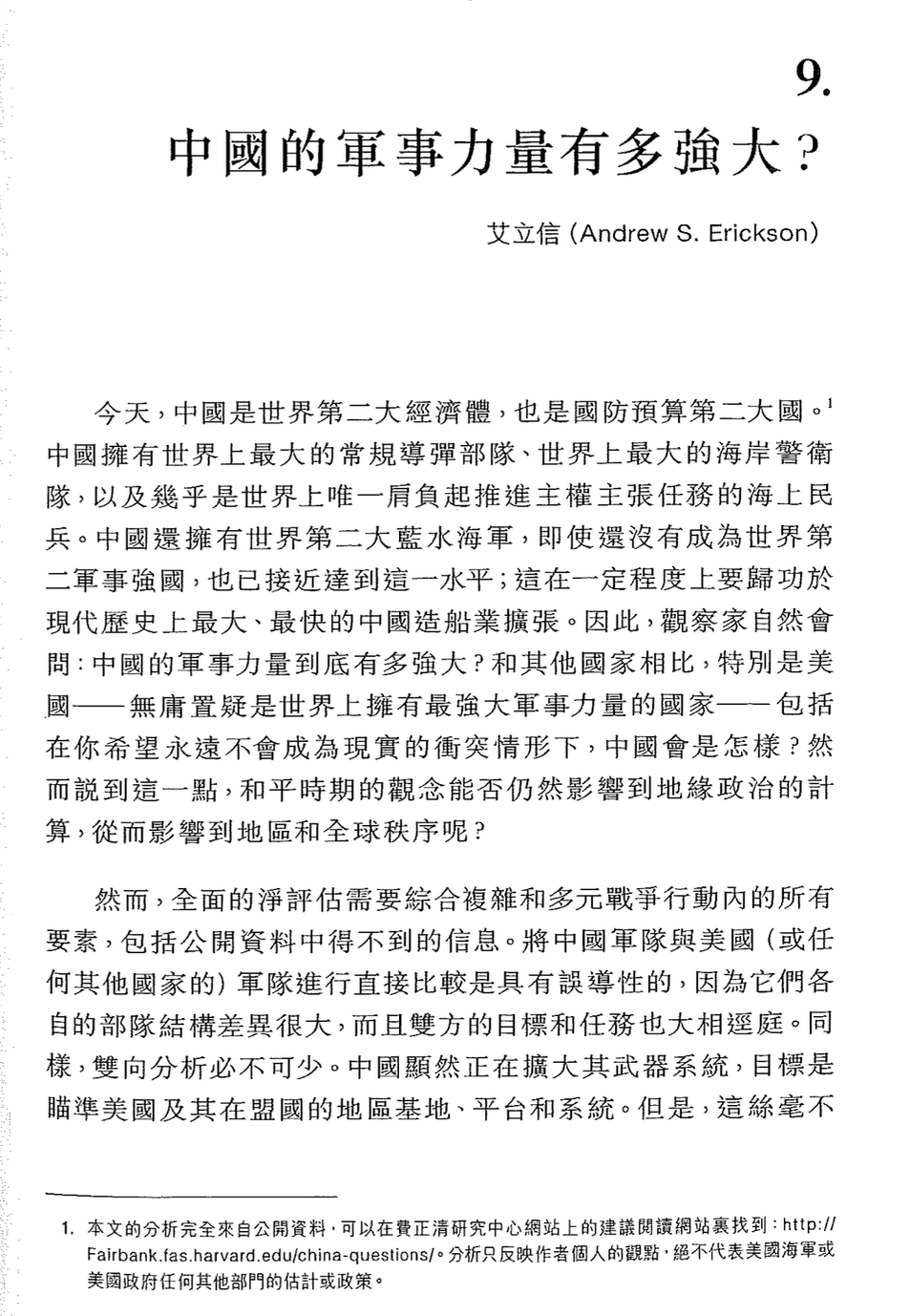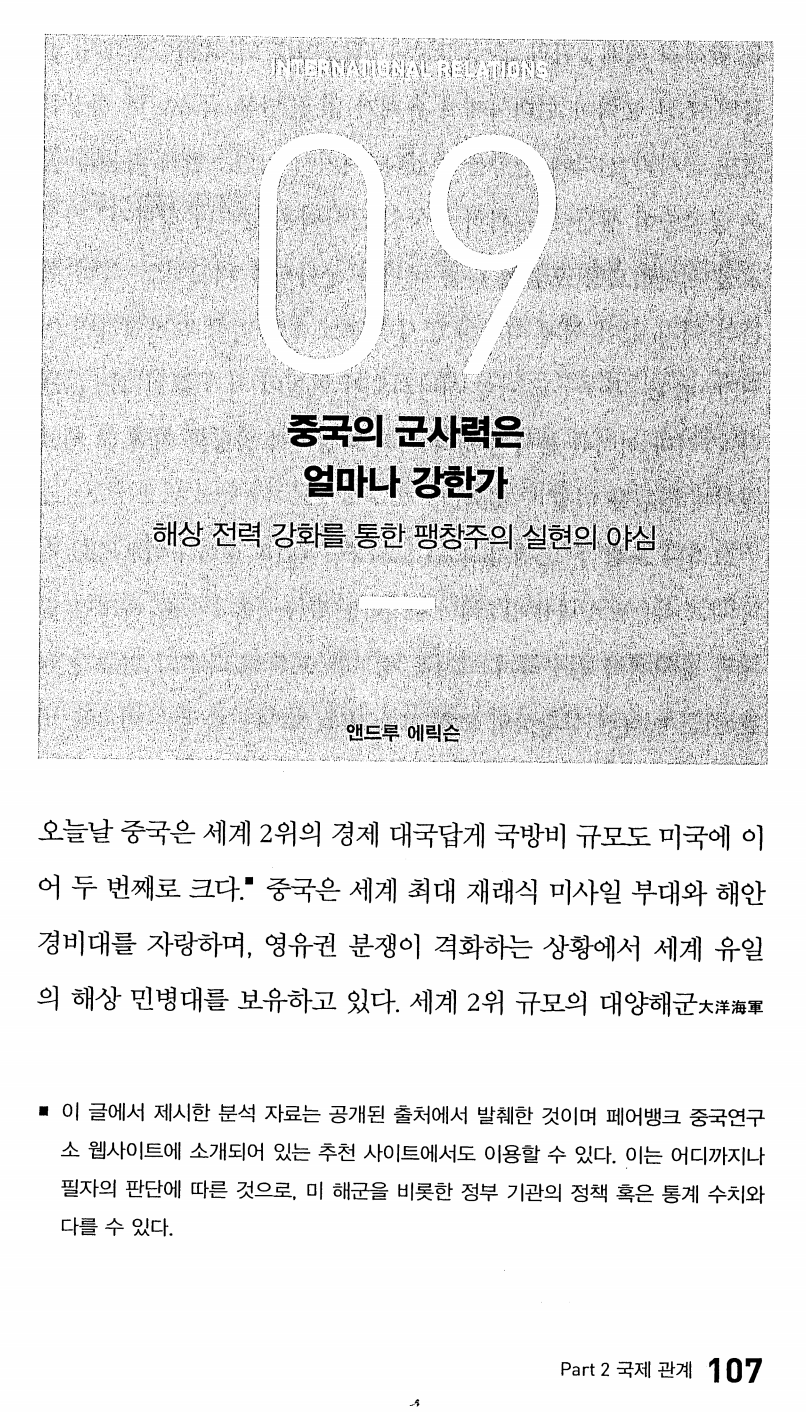How Strong Are China’s Armed Forces?
Andrew S. Erickson, “How Strong Are China’s Armed Forces?” in Jennifer Rudolph and Michael Szonyi, eds., The China Questions: Critical Insights into a Rising Power (Cambridge, MA: Harvard University Press, 2018), 73–80.
- Simplified Chinese translation: 艾立信 [Andrew S. Erickson], “中国的军事力量有多强大?” [How Strong Are China’s Armed Forces?], in 陆德芙 [Jennifer Rudolph] and 宋怡明 [Michael Szonyi], 编 [Editors]; 余江 [Yu Jiang] and 郑言 [Zheng Yan], 译 [Translators]; 中国36问—对一个崛起大国的洞察 [The China Questions: Critical Insights into a Rising Power] (Cambridge, MA: 哈佛大学费正清中国研究中心 [John King Fairbank Center for Chinese Studies, Harvard University], 2020), 63–68.
- Traditional Chinese translation: 艾立信 [Andrew S. Erickson], “中國的軍事力量有多強大?” [How Strong Are China’s Armed Forces?], in 陸德芙 [Jennifer Rudolph] and 宋怡明 [Michael Szonyi], 編 [Editors]; 余江 [Yu Jiang] and 鄭言 [Zheng Yan], 譯 [Translators], 中国36问—对一个崛起大国的洞察 [The China Questions: Critical Insights into a Rising Power] (香港 [Hong Kong]: 香港城市大學出版社 [City University of Hong Kong Press], 2019), 63–68.
- Korean translation: 앤드류 에릭슨 [Andrew Erickson], “중국의 군사력은 얼마나 강한가” [How Strong Are China’s Armed Forces?], in 마이클 스조니 [Michael Szonyi] and 제니퍼 루돌프 [Jennifer Rudolph], eds.; 이은주 [Lee Eun-joo, translator]; 하버드대학 중국 특강 : 하버드 석학들의 36가지 질문 중국의 현재와 미래를 묻다 하버드대학 중국연구소 [Harvard University Special Lecture on China: 36 Questions Harvard Scholars at Harvard University’s China Institute Ask About the Present and Future of China], (서울 [Seoul]: 미래의창 [Future Window Publishing], 2018), 107–17.
Today, China has the world’s second-largest economy and defense budget.[*] It boasts the world’s largest conventional missile force, the world’s largest coast guard, and virtually the world’s only maritime militia charged with advancing sovereignty claims. If not already the world’s second most powerful country, with the second-largest blue-water navy, it is on the verge of achieving those ranks; this is thanks in part to the largest, fastest shipbuilding expansion in modern history. Hence, it is only natural for observers to ask: How strong, exactly, are China’s armed forces? And how would they compare with those of other nations, particularly those of the United States—undisputably the world’s strongest—including in conflict scenarios that one hopes will never materialize but, with respect to which, peacetime perceptions can nevertheless influence geopolitical calculations and, thereby, the regional and global order?
A comprehensive net-assessment, however, requires all elements of complex, multivariate campaign equations, including information unavailable in open sources. Outright comparison of Chinese armed forces with American (or any other) counterparts is misleading because their respective force structures differ significantly, and the two sides have very different objectives and missions. Bi-directional analysis is, likewise, essential. China is clearly expanding its inventory of weapons systems capable of targeting US and allied regional bases and vessels. But this says nothing of the countermeasures that the targeted forces might employ, nor of the ways in which they might successfully target their Chinese counterparts. This essay therefore considers both the most critical dynamics affecting the relevant equations, particularly vis-à-vis China itself, and the authoritative judgments offered by the latest unclassified US government reports.
Key Dynamics
Understanding China’s national security policies and power requires consideration of all three major components of China’s armed forces: the People’s Liberation Army (PLA), the paramilitary People’s Armed Police (PAP), and the Militia. The United States is exceptional in its enviable combination of resources, innovation, decentralized governance, peaceful neighbors, oceanic access, and lack of sovereignty disputes. These factors enable expansive external security policies and operations by clearly defined military forces. Chinese national security is far more geographically confined, continuous, complex, and contested. While the PLA is the primary tool for combat operations far from China, elite maritime units within China’s militia participate in sovereignty promotion operations vis-à-vis regional features and waters claimed by Beijing, and the PAP underpins domestic and border security.
China’s armed forces, and the policies that inform their construction and use, have been shaped by Beijing’s evolving hierarchy of national security interests. Having consolidated political, domestic, and (the vast majority of) border security, at least for now, the CCP is operationalizing its security priorities externally in progressively diminishing “ripples of capability” beyond China’s mainland. Now, and likely for years to come, the area of most intense development concerns the Near Seas (Yellow, East China, and South China Seas), home to all China’s outstanding island and maritime sovereignty claims.
To this end, Beijing is developing its armed forces with a view to targeting vulnerabilities in the forces of the United States and its regional allies and security partners to radically raise the risk they would face in intervening in Chinese sovereignty disputes. It is doing so in part by emphasizing missiles and other land-based, counter-intervention systems that are considerably cheaper and easier to build and employ than to defend against, bringing new relevance to the traditional PLA concept of “using the land to control the sea.” Beijing’s goal its to “win without fighting” and achieve deference to its “core” security interests, perhaps in part by becoming the preponderant East Asian power.
It pursues this end in a twofold manner: (1) at the high end, deterring foreign military intervention in the first place through a combination of demonstrating capabilities (ideally not using them lethally) in a way that intimidates the United States and its allies with the prospect of paying unacceptable costs; and (2) at the low end, achieving incremental progress below the threshold of war through “gray zone” coercion of rival claimants using primarily its coast guard and maritime militia. To enhance China’s prospects for realizing these objectives, President Xi Jinping, who is also Chairman of the Central Military Commission, has charged the PLA with ambitious reforms to strengthen its ability to wage modern wars, while bolstering China’s other two armed forces.
Estimates and Projections
US government publications draw on comprehensive, robust, carefully vetted data and analysis that is largely unavailable to outside observers until long after their release. They have demonstrated their merit over time by the great degree to which their findings correspond to verifiable facts. Reports by US government-affiliated think tanks and their analysts are less demonstrably authoritative but offer greater diversity and specificity of insights. To these may be added Chinese government and open sources, which rarely provide detailed net-assessments but offer useful context when considered critically.
These sources conclude collectively that, in recent years, the PLA has greatly increased its ability to conduct operations in support of Beijing’s objectives vis-à-vis the Near Seas, but that these capabilities diminish sharply beyond that margin. Given China’s priorities and capabilities, the two leading Near Seas contingencies commonly analyzed by US government and related sources concern Taiwan and contested Chinese claims in the South China Sea’s Spratly Islands. Assessments generally conclude that, over the next fifteen years or so, US forces will retain their ability to prevail over the PLA in a protracted war, but that the PLA might temporarily achieve superiority in specific sea- and air-spaces, and US victory would be far costlier than it would have been years ago.
A Taiwan scenario remains the PLA’s leading high-end planning factor. It is widely regarded as able to engage in militarily significant operations, such as seizing a Taiwan-held offshore island or launching missile strikes on Taiwan proper. Such actions would almost certainly be counterproductive politically, however. A more sophisticated blockade would likely fail if opposed forcefully by Washington, making American intervention a decisive factor. An outright amphibious invasion of Taiwan’s main island remains unrealistic, given both PLA force structure limitations and Taiwan’s ability to exploit its formidable natural defenses.
The South China Sea is a far more permissive environment for China’s armed forces. At stake is not a sophisticated society of 23.5 million that Beijing claims as Chinese compatriots but, rather, isolated islands and reefs that are sparsely inhabited at most, and sustain few, if any, indigenous people. Given the relative weakness of neighboring countries with whom China has disputed claims, China’s coast guard and maritime militia can engage in multifarious “gray zone” operations, to significant effect. Regarding potential major combat operations, the PLA could likely prevail over rival militaries absent American involvement. Were US forces to intervene, for example, to support Washington’s Philippine ally in a crisis or conflict with China, both sides could face significant operational challenges. The PLA would have difficulty deploying adequate forces to the highly vulnerable Spratly Islands and resupplying them there. Should it somehow succeed in massing sufficient forces with some element of surprise, however, it might confront Washington with unappealing alternatives.
Further afield, spurred largely by growing overseas interests, as encapsulated in part by Xi’s “One Belt, One Road” initiative (which proposes to extend China’s economic and political influence along the former Silk Road to Europe, as well as by sea), China is weaving an outer layer of substantive and influential but less intensive capabilities. These are enabling selective forays to protect Chinese citizens and assets abroad, including through evacuations from Libya and Yemen and anti-piracy escorts in the Gulf of Aden. The last, together with growing UN peacekeeping participation, offer welcome examples of growing international security contributions. Chinese developments enabling more formidable maritime power projection—including aircraft carrier operations and enhancing access to overseas facilities, possibly in part by developing further naval support-points beyond the initial one materializing in Djibouti—are progressing more gradually.
Implications
The aforementioned dynamics are poised to shape the capability of China’s armed forces for the foreseeable future. Geography will remain foremost among them, making it imperative to view Chinese national security prospects “through the lens of distance.” China has already arrived as a great power with formidable armed forces. Close to home, to the extent that the CCP retains favorable conditions domestically, it will retain and likely build on powerful synergies and advantages vis-à-vis the sovereignty claims that it prioritizes along its contested maritime periphery. Even as China’s armed forces advance substantially overall, however, the Party-state that guides and supports them may face an economy with significant downside risks, an overall slowing in the growth rate of all elements of national power, and perhaps mounting challenges from within. The result is almost certain to be more complex national security tradeoffs and policy choices than Beijing has faced since the late 1970s, with the possible exception of domestic instability in 1989. Given the likelihood that national narratives and prioritization concerning unresolved sovereignty claims will persist, external security debates and policy adjustments will probably moderate plans regarding some of the more demanding high-end combat capabilities specific to long-range power projection.
Farther afield, Chinese military progress—beyond the emerging basic capabilities of presence and non-traditional security operations—toward growing ability to contest other capable militaries will come with a steep price. Increasing convergence will bring China the same rising costs and diminishing returns that notoriously plague established Western militaries as they struggle to maintain their relative standing amid competing national priorities and evolving competitors. All three of China’s armed forces will face escalating personnel-related costs. Structural and organizational reform will require intensified investment and impose associated demobilization costs. As with Western militaries, rising salaries and benefits to attract, educate, train, and retain capable professionals will consume an increasing portion of the budget. Growing entitlements will likewise impose a mounting burden, particularly as more retirees draw benefits that are already quite generous in some respects.
As China’s most sophisticated armed force, the PLA will additionally face particularly significant technological requirements and attendant challenges. The closer it approaches leading-edge capabilities, the more expensive and difficult it will be to advance further, or even to retain a stable position vis-à-vis foreign competitors. Cutting-edge innovation is difficult and expensive—a burden that has long plagued the United States. Weapons systems and associated infrastructure will become progressively costlier to build, operate, and maintain than their simpler predecessors. China’s cost advantages decrease as military equipment centers less on labor and more on advanced materials and technology. The more sophisticated and technology-intensive PLA systems become, the less relative benefit China derives from acquiring and indigenizing foreign technologies, and the less cost advantage it will have in producing and maintaining them. Additionally, propulsion, electronics, and other complex systems-of-systems hinging on the precise interaction of demanding apex technologies remain a key Chineseweakness—in part because they defy China’s preferred approach of combining domestic and foreign technologies piecemeal.
Nevertheless, Beijing already enjoys formidable means to promote its Near Seas objectives without approaching American technological sophistication; such leading-edge accomplishment is far more essential to long-distance warfare. Again, geography matters.
Such are the unrelenting undercurrents of China’s meteoric military-security development, which faces meaningful constraints from the prospect of US opposition as well as long-range challenges, just as surely as it enjoys short-range opportunities and is working hard to exploit them.
NOTE:
[*] The analysis here is derived solely from open sources, which may be found at the suggested reading site hosted on the Fairbank Center website http://fairbank.fas.harvard.edu/china-questions/. It reflects the views of the author alone. It does not represent the estimates or policies of the US Navy or any other organization of the US government.
SIMPLIFIED CHINESE TRANSLATION OF MY CHAPTER:
艾立信 [Andrew S. Erickson], “中国的军事力量有多强大?” [How Strong Are China’s Armed Forces?], in 陆德芙 [Jennifer Rudolph] and 宋怡明 [Michael Szonyi], 编 [Editors]; 余江 [Yu Jiang] and 郑言 [Zheng Yan], 译 [Translators]; 中国36问—对一个崛起大国的洞察 [The China Questions: Critical Insights into a Rising Power] (Cambridge, MA: 哈佛大学费正清中国研究中心 [John King Fairbank Center for Chinese Studies, Harvard University], 2020), 63–68.
本文的分析完全来自公开资料,可以在费正清研究中心网站上的建议阅读网站里找到: http:// Fairbank.fas.harvard.edu/china-questions/。分析只反映作者个人的观点,绝不代表美国海军 或美国政府任何其他部门的估计或政策。
今天,中国是世界第二大经济体,也是国防预算第二大国。 中国拥有世界上最大的常规导弹部队、世界上最大的海岸警 卫队,以及几乎是世界上唯一肩负起推进主权主张任务的海上 民兵。中国还拥有世界第二大蓝水海军,即使还没有成为世界 第二军事强国,也已接近达到这一水平;这在一定程度上要归 功于现代历史上最大、最快的中国造船业扩张。因此,观察家 自然会问:中国的军事力量到底有多强大?和其他国家相比, 特别是美国—毋庸置疑是世界上拥有最强大军事力量的国家 —包括在你希望永远不会成为现实的冲突情形下,中国会是怎 样?然而说到这一点,和平时期的观念能否仍然影响到地缘政治的计算,从而影响到地区和全球秩序呢?
然而,全面的净评估需要综合复杂和多元战争行动内的所 有要素,包括公开资料中得不到的信息。将中国军队与美国(或 任何其他国家的)军队进行直接比较是具有误导性的,因为它 们各自的部队结构差异很大,而且双方的目标和任务也大相迳 庭。同样,双向分析必不可少。中国显然正在扩大其武器系统, 目标是瞄准美国及其在盟国的地区基地、平台和系统。但是,这丝毫不能说明被瞄准的部队可能采取的反制措施,也没有说 明他们可能以某种方式成功瞄准中国。因此,本文既考虑到影 响相关局势的最关键动力,尤其是对中国自身的影响,也考虑 了美国政府最新发布的非机密报告所作出的权威判断。
关键动态
要了解中国的国家安全政策和武力情况,需要考虑到中国 的三个主要武装力量:中国人民解放军(PLA)、准军事组织 武装警察部队(PAP)和民兵。美国因结合资源、创新、分权治 理、和平邻国、海洋通道和没有主权争端等令人羡慕之特质而 独树一帜。透过明确界定军事力量,这些因素能有助实施广泛 的外部安全政策和行动。中国的国家安全具有更多的地域限 制、连续性、复杂性和争议性。虽然解放军主要用于参与远离 中国国土的作战行动,但中国的精锐海上民兵部队亦有参与在 北京当局宣称拥有主权的区域和水域的主权提升行动,而武装 警察部队则负责维护中国国内和边境安全。
中国的武装力量,以及规管其建设和运用的国防政策,都 是由北京当局不断变化的国家安全利益等级所决定的。在巩固 政治、国内和(绝大部分的)边境安全之后,至少就目前而言, 中国共产党正在将国家安全重点集中在对外安全方面,逐步削 弱中国大陆以外的”军事力量涟漪”(ripples of capability)。 现在,并且很可能在未来多年里,最可能出现紧张局势的区域 是近海(即黄海、东海和南海),中国所有悬而未决的岛屿和海 洋主权争议都集中在这些海域。
为此,北京当局在建立其武装力量时,以打击美国及其地 区盟友和安全伙伴的武装弱点为目标,希望大幅提高它们在干 预中国主权争议时面临的风险。中国这样做有部分是为了强调 陆基反导拦截系统的建设。这些系统比防御系统成本低廉得 多,也更容易建造和使用,为解放军传统的”以陆制海”观念带来新思维。北京当局的目标是”不战而屈人之兵”,使其”核心”安 全利益得到尊重。这一目标也许要通过成为东亚主要军事强国 才能实现。
中国从两方面来追求这一目标:(1)在高端方面,首先通过 展示中国的军事力量(最好不要使用致命的武力),并以未来 可能要付出无法接受的代价来阻吓美国及其盟国,务求阻止外 国的军事干预;(2)在低端方面,主要利用海岸警卫队和海上 民兵,对对手采用”灰色地带”威胁,以在战争门槛以下取得渐 进式进展。为了增强中国实现这些目标的前景,国家主席兼中 央军委主席习近平要求中国人民解放军实施雄心勃勃的改革, 以加强其发动现代战争的能力,同时提高中国另外两支武装力 量。
估算和预测
美国政府出版的刊物采用了全面、可靠、经过仔细审核的 数据和分析。这些数据和分析大多要在政府发布一段很长时 间后,才能被外部观察家所知。随着时间流逝,我们知道政府 刊物的分析在很大程度上均符合真实情况,故证明了其价值。 相较之下,与美国政府有关的智库及分析师发表的报告,并不 具有明确的权威性,但却提供了更多样和具体的见解。除此之 外,还有中国政府和一些公开资料来源,它们很少提供详细的 净评估,但为审视问题提供了有用的背景资料。
这些消息来源共同得出的结论是:近年来,中国人民解放 军已大大增强其军事能力,以支持北京当局有关近海的军事行 动,但这些能力在这一范围以外却在急剧下降。考虑到中国的 重点项目和能力,美国政府和相关消息来源通常分析的两个主 要有关近海的意外事件,均涉及台湾和中国在南海南沙群岛的 领土争议。评估普遍认为,在未来15年左右,美军将保持在持 久战中战胜解放军的能力,但解放军可能暂时在特定海域和空域取得优势,而美军要取得胜利将会付出比几年前更高的代 价。
台湾局势仍然是解放军主导的高端规划因素。外界普遍认 为,中国有能力采取重大军事行动,比如夺取台湾控制的近海 岛屿,或者对台湾本土发动导弹攻击。然而,这样的行动在政 治上几乎肯定会适得其反。如果遭到华盛顿的强力反对,更精 密的封锁很可能会失败,所以美国的干预成为决定性因素。鉴 于解放军兵力结构的限制和台湾强大的自然防御能力,以海陆 两方位直接入侵台湾的主要岛屿仍然是不切实际的。
对中国军队来说,南海的环境较为宽松。这里危及到的, 不是一个由2350万北京当局声称是中国同胞组成的复杂社会, 而是一些居住着极少数原住民的偏远岛屿,以及海边的稀有礁 石。鉴于与中国有领土争议的邻国均相对弱小,中国的海警和 海上自卫队可以开展各种各样的”灰色地带”行动,成效显著。 至于潜在的大规模战斗行动,如果美国没有参与其中,解放军 可能会战胜敌对军队。但是,若美军干预,例如在与中国的危 机或冲突中支持其盟友菲律宾,那么双方的作战行动都可能面 临重大挑战。解放军将难以在防守极其薄弱的南沙群岛部署充 足的兵力,并为他们提供补给。但是,假如它能够成功集结充 足的兵力,并具备某些出人意料的手段,那么它可能会令美国 面对毫无吸引力的选择。
在更远的地方,很大程度上受到不断增长的海外利益的刺 激,正如习近平的”一带一路”倡议(提议将中国的经济和政治 影响力沿着以前的陆上丝绸之路延伸到欧洲,以及沿着海上 丝绸之路延伸至沿岸各国)所概括的,中国正在编制一个实质 性、有影响力但不那么密集的外部力量。这些举措使中国能够 采取有选择性的突击行动,以保护中国公民和海外资产,包括 从利比亚和也门撤离,以及在亚丁湾进行反海盗护航行动。最 后,加上中国在参与联合国维和行动方面日渐增多,中国也以 许多可喜的事例,为国际安全作出愈来愈大的贡献。中国的发展使之能够逐渐在海上投入更令人生畏的军事力量,包括实施 航空母舰行动和加强对海外设施的利用,这有部分可能要通过 在吉布提(Djibouti)以外地区,开设更多军事基地,为海军提 供支援。
影响
上述动力将决定中国军队在可预见的将来的能力。地理因 素仍将会是重中之重,因此必须”从一定的距离”来看待中国的 国家安全前景。中国已经成为一个拥有强大武装力量的大国。 在接近其国土的情况下,只要中共在国内保持有利条件,相较 于与其有主权争议的周边海域,它将保持并很有可能建立起强 大的协同效应和优势。然而,尽管中国武装力量整体上取得进 步,但指导和支持军队的中共党国政府可能会面临重大的经济 下行风险,国家实力的所有要素的增长速度整体放缓,同时来 自内部的挑战也亦会不断增加。几乎可以肯定的是,这结果会 导致北京面临比1970年代末以来各个时期—可能只有1989年 的国内动荡除外—更为复杂的国家安全权衡和政策选择。鉴于 与尚未解决的主权主张相关的国家陈述和优先次序可能会继 续存在,外部安全争论和政策调整可能会缓和针对长远实力预 测的一些要求更高的高端作战能力计划。
在更远的地方,中国的军事进程旨在提高与其他强力军队 对抗的实力,以超越当前和非传统安全行动的新兴基本能力, 而它将要为此付出高昂的代价。中国在军事上与一些西方老牌 军事强国的日趋相同,令其面临成本不断上升、回报不断下降 的相同局面,而这正是那些曾经深受其害的西方国家军队在面 临国家要务和不断演变的竞争对手之时,为竭力维持其相应的 地位而出现的问题。中国的三个武装力量都将面临与人员相关 的费用不断上涨的问题。结构和组织改革将要加大投资,并增 加相关的军人退伍复员费。与西方军队一样,以提高军人薪酬和福利来吸引、教育、培训和留住有能力的专业人员,这将会 增加相应的开支预算。退休人员所享有的权利不断增加,亦同 样会加重武装部队的开支负担,尤其是随着愈来愈多退休人员 已经在某些方面获得相当丰厚的福利。
作为中国最先进的武装力量,解放军还将面临特别重大的 技术要求和随之而来的挑战。它愈接近尖端能力,就愈难继续 进步,而所需成本亦会变得愈来愈高昂,甚至难以与外国对手 在竞争中保持稳定地位。尖端创新既困难又昂贵—这曾是长 期困扰着美国的负担。武器系统和相关基础设施的建造、营运 和维修工作,相较其简单的前身,成本将愈来愈高。随着军事 装备愈来愈依赖先进的材料和技术,而非劳动力,中国的成本 优势正在下降。解放军的武器系统愈先进,技术愈精密,中国 从引入外国技术并将它本土化中所获得的好处就会相对减少, 而在利用这些技术进行生产和维修工作的成本优势则愈小。此 外,依靠尖端技术之间的精确相互作用之推进、电子和其他复 杂系统,仍然是中国的一个主要弱点—有部分原因是它们与中 国选择将零散的国内外技术结合起来的做法背道而驰。
然而,北京已经拥有强大的手段,在不接近美国的先进技 术的情况下,推进其近海目标。美国尖端技术的成就对远程战 争而言至关重要,但地理亦同样很重要。
这就是中国军事安全迅速发展的持续的暗流。中国军事发 展会因为美国的反对声音和长期挑战而受到重大限制,但同样 亦肯定享有短期的机遇,而中国当局正在努力利用这些机遇。
INFORMATION ON THE EDITED VOLUME:
Jennifer Rudolph and Michael Szonyi, eds., The China Questions: Critical Insights into a Rising Power (Cambridge, MA: Harvard University Press, 2018).
Published to celebrate the 60th Anniversary of Harvard University’s John King Fairbank Center for Chinese Studies with 36 chapters contributed by its faculty and affiliates, The China Questions presents the most important issues in the fields of China’s politics, international relations, economy, environment, society, and history and culture.
Click here to order from Harvard University Press.
For media inquiries, please contact James Evans at jamesevans [at] fas.harvard.edu.
Click here to Google Search inside the volume.
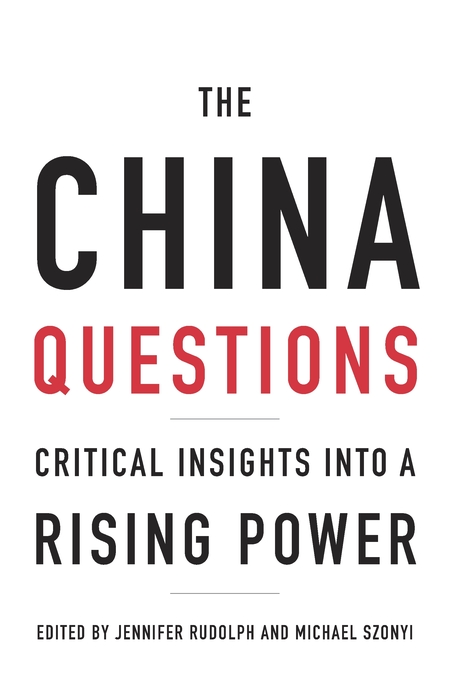
ABOUT THE EDITORS
Jennifer Rudolph is Associate Professor of modern Chinese political history at Worcester Polytechnic Institute.
Michael Szonyi is Professor of Chinese History at Harvard University.
BOOK DESCRIPTION
Many books offer information about China, but few make sense of what is truly at stake. The questions addressed in this unique volume provide a window onto the challenges China faces today and the uncertainties its meteoric ascent on the global horizon has provoked.
In only a few decades, the most populous country on Earth has moved from relative isolation to center stage. Thirty of the world’s leading China experts—all affiliates of the renowned Fairbank Center for Chinese Studies at Harvard University—answer key questions about where this new superpower is headed and what makes its people and their leaders tick. They distill a lifetime of cutting-edge scholarship into short, accessible essays about Chinese identity, culture, environment, society, history, or policy.
Can China’s economic growth continue apace? Can China embrace the sacrifices required for a clean environment? Will Taiwan reunite with the mainland? How do the Chinese people understand their position in today’s global marketplace? How do historical setbacks and traditional values inform China’s domestic and foreign policy? Some of the essays address issues of importance to China internally, revolving around the Communist Party’s legitimacy, the end of the one-child policy, and ethnic tensions. Others focus on China’s relationship with other nations, particularly the United States. If America pulls back from its Asian commitments, how will China assert its growing strength in the Pacific region?
China has already captured the world’s attention. The China Questions takes us behind media images and popular perceptions to provide insight on fundamental issues.
BLURBS
“Rudolph and Szonyi, both associated with Harvard’s Fairbank Center for Chinese Studies, bring together 36 short, but collectively weighty, scholarly articles on contemporary China. The articles are grouped into six categories: China’s politics, foreign relations, economy, environment, society, and history and culture. This collection is impressive for its comprehensiveness, with contributors providing numerous pointed observations.”
—Publisher’s Weekly, 2017.
- Introduction [Michael Szonyi] 1
I. POLITICS
1. Is the Chinese Communist Regime Legitimate? [Elizabeth J. Perry] 11
2. Can Fighting Corruption Save the Party? [Joseph Fewsmith] 18
3. Does Mao Still Matter? [Roderick MacFarquhar] 26
4. What Is the Source of Ethnic Tension in China? [Mark Elliott] 33
5. What Should We Know about Public Opinion in China? [Ya-Wen Lei] 43
6. What Does Longevity Mean for Leadership in China? [Arunabh Ghosh] 51
7. Can the Chinese Communist Party Learn from Chinese Emperors? [Yuhua Wang] 58
II. INTERNATIONAL RELATIONS
8. Will China Lead Asia? [Odd Arne Westad] 67
9. How Strong Are China’s Armed Forces? [Andrew S. Erickson] 73 (pp. 73-80)
10. What Does the Rise of China Mean for the United States? [Robert S. Ross] 81
11. Is Chinese Exceptionalism Undermining China’s Foreign Policy Interests? [Alastair Iain Johnston] 90
12. (When) Will Taiwan Reunify with the Mainland? [Steven M. Goldstein] 99
13. Can China and Japan Ever Get Along? [Ezra F. Vogel] 110
III. ECONOMY
14. Can China’s High Growth Continue? [Richard N. Cooper] 119
15. Is the Chinese Economy Headed toward a Hard Landing? [Dwight H. Perkins] 126
16. Will Urbanization Save the Chinese Economy or Destroy It? [Meg Rithmire] 133
17. Is China Keeping Its Promises on Trade? [Mark Wu] 141
18. How Do China’s New Rich Give Back? [Tony Saich] 148
19. What Can China Teach Us about Fighting Poverty? [Nara Dillon] 155
IV. ENVIRONMENT
20. Can China Address Air Pollution and Climate Change? [Michael B. McElroy] 165
21. Is There Environmental Awareness in China? [Karen Thornber] 173
V. SOCIETY
22. Why Does the End of the One-Child Policy Matter? [Susan Greenhalgh] 183
23. How Are China and Its Middle Class Handling Aging and Mental Health? [Arthur Kleinman] 191
24. How Important Is Religion in China? [James Robson] 199
25. Will There Be Another Dalai Lama? [Leonard W. J. van der Kuijp] 206
26. Does Law Matter in China? [William P. Alford] 212
27. Why Do So Many Chinese Students Come to the United States? [William C. Kirby] 219
VI. HISTORY AND CULTURE
28. Who Is Confucius in Today’s China? [Michael Puett] 231
29. Where Did the Silk Road Come From? [Rowan Flad] 237
30. Why Do Intellectuals Matter to Chinese Politics? [Peter K. Bol] 244
31. Why Do Classic Chinese Novels Matter? [Wai-yee Li] 252
32. How Have Chinese Writers Imagined China’s Future? [David Der-wei Wang] 261
33. Has Chinese Propaganda Won Hearts and Minds? [Jie Li] 268
34. Why Is It Still So Hard to Talk about the Cultural Revolution? [Xiaofei Tian] 276
35. What Is the Future of China’s Past? [Stephen Owen] 283
36. How Has the Study of China Changed in the Last Sixty Years? [Paul A. Cohen] 288
- Further Reading 297
- Acknowledgments 309
- Contributors 311
- Index 325
PRODUCT DETAILS
Hardcover
$27.95 • £22.95 • €25.00
ISBN 9780674979406
Available 12/11/2017
352 pages
5-1/2 x 8-1/4 inches
4 graphs, 2 tables
RELATED SUBJECTS
History: Asia: China
Political Science: World: Asian
Social Science: Developing & Emerging Countries
Political Science: International Relations: General
FURTHER READING
- Click here and select “Further Readings” tab to access a supplementary bibliography more comprehensive than the abbreviated one in the physical volume.
- Click here to browse a selection of Harvard University Press works on the history and politics of China.
- At Boston Review, read Roderick MacFarquhar’s contribution to this volume, on the relevancy of Mao Zedong in today’s China.

